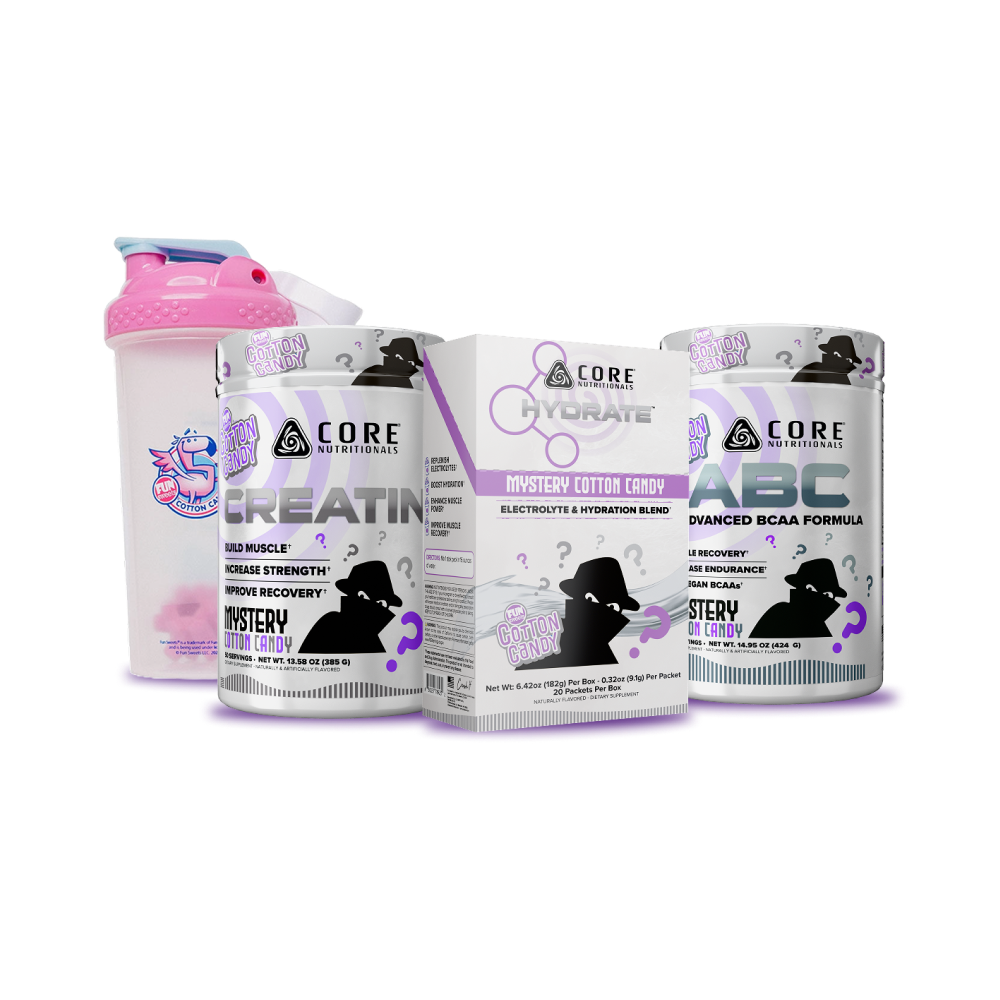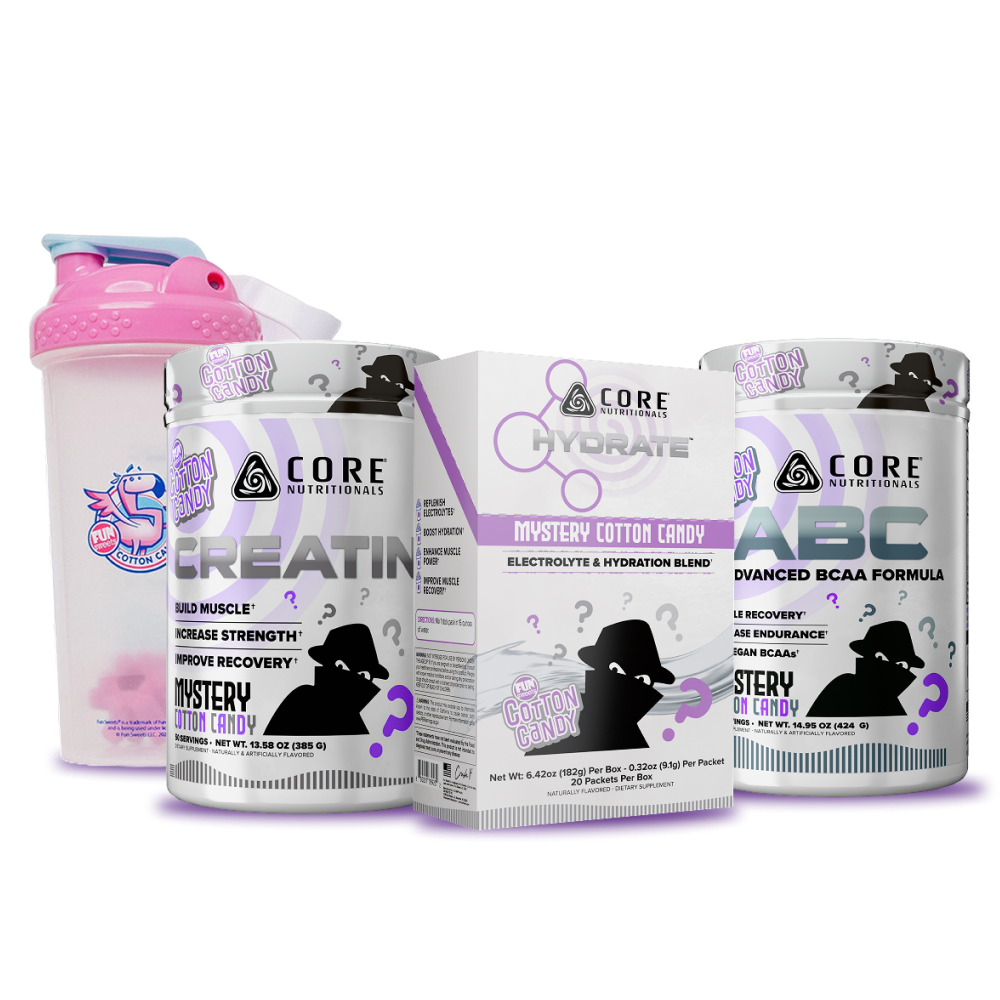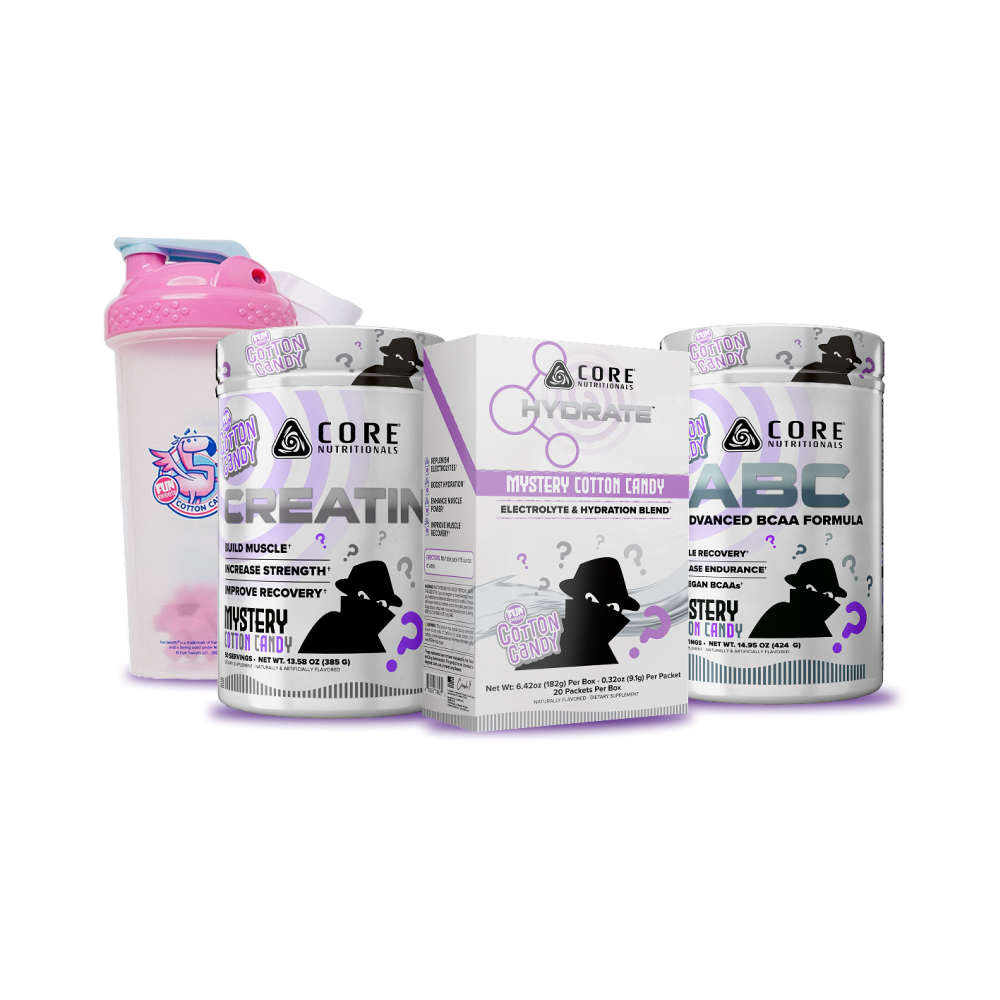
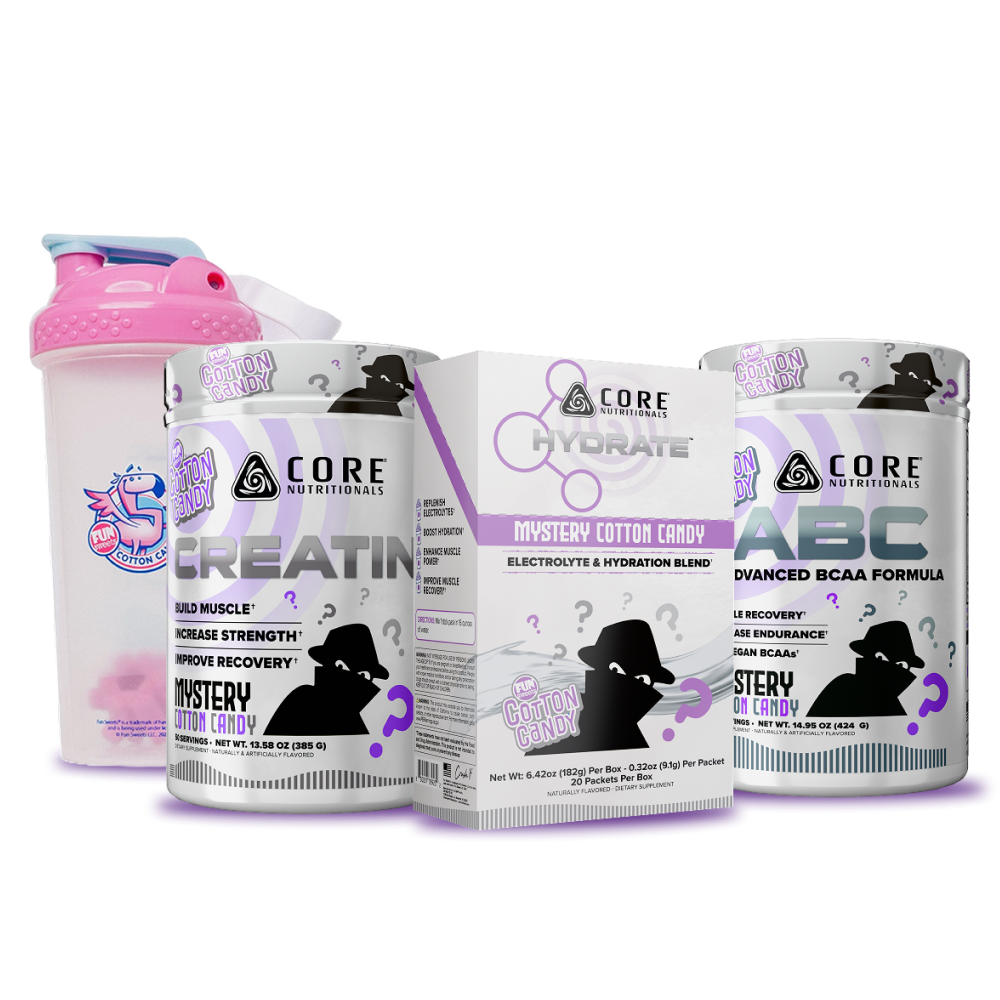
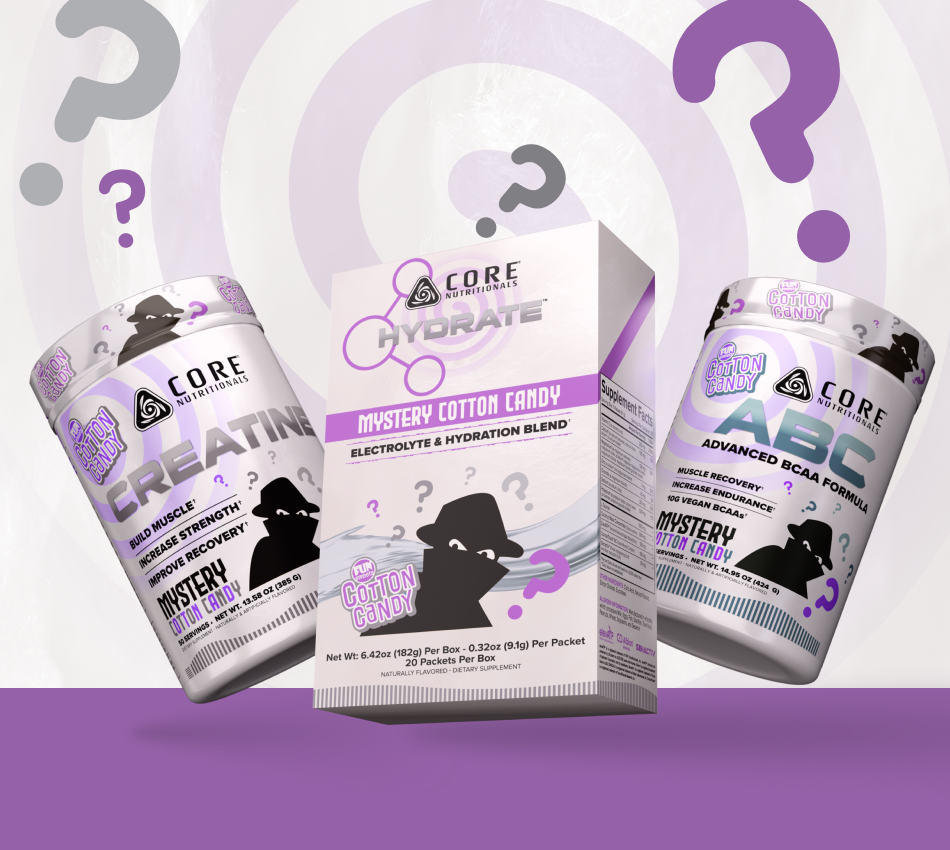
Core Nutritionals Creatine, Hydrate, and ABC
-
Creatine
Creatine is perhaps the most studied and verified of all dietary supplements, earning its moniker as the, “grandfather of supplements.” Through a number of enzymatic and cellular steps, creatine is first metabolized into a compound known as phosophocreatine, and eventually into a compound known as ATP (adenosine triphosphate) – the so-called, “energy currency” of the human body. As a dietary supplement, the use of creatine over extended periods of time has been linked to a wide-range of physiological benefits, including: cell volumization, increased delivery of plasma (blood) nutrients to the cell, an increase in skeletal muscle total mass and protein synthesis, decrease in muscular fatigue, and increased endurance.
ABC
Rep by rep. Mile by mile. Breath by breath. Every muscle screams at you with pleas of mercy; every bone aches to its core from the pressure. Yet, you still don’t quit – you push on. By hook, or by crook, you will make it. You will succeed. You will win.
You see, you’re an athlete. You are someone defined to your core by the competitive drive to better yourself at all costs. You need neither trophies, nor accolades; neither cheers, nor recognition. You pay the sweat price for every gain marked in your battle-worn ledger, detailing the struggle your body has endured.You’re an athlete, and so are we. We don’t make Core ABC for everyone, we make it for you and us. We use the most effective, scientifically-established ratio of BCAAs because we know it’s the difference between your first mile and your last. We include clinically-verified servings of beta-alanine, citrulline malate, and glutamine because we know your last rep depends on it. We know this because we know you, and we know ourselves.
Core ABC is the athlete’s BCAA. It was formulated by athletes, for athletes, for the needs only an athlete can understand. If you can’t say the same about your BCAA, then it may be time for a switch.
Physiological Properties and Effects:
Amino Acids:
If one were to think of the body as a construction project, amino acids would be the most basic building materials: raw lumber, mortar, bricks, and so on. While the assembly of these building blocks is of course critically important to the function of the building – and one of the amino acids, leucine, controls its own assembly – the quality and availability of the materials themselves is arguably more important. Not enough concrete? The foundation cracks and the building falls.
Your body is the exact same way. It is comprised of various amino acids, both essential and non-essential, that comprise the cellular basis of each and every cell in your body. When it comes down to skeletal muscle, the three most important are known as the BCAAs – or branch chained amino acids. Comprised of leucine, isoleucine, and valine, these three little amino acids effectively control the rate at which your muscle grows (hypertrophies), its contractile force, its endurance, and so on – to say they are massively important is an understatement. For this reason, they form the basis of any competently-designed supplement protocol.
Collectively, as stated above, the branch-chained amino acids leucine, isoleucine, and valine are famous for their role in skeletal muscle protein synthesis and metabolism, and additionally comprise approximately one-third of all skeletal muscle protein. Of the three, leucine is both the most physiologically important with respect to muscle mass, and the most extensively studied. Data on leucine demonstrate this amino acid plays critical roles in stimulating skeletal muscle protein synthesis, and ribosomal biogenesis and assembly (the literal building of muscle tissue), along with playing a lesser role in insulin signaling and gluconeogenic processes. As a result of these diverse roles, leucine has been demonstrated to significantly stimulate skeletal muscle protein synthesis, and attenuate protein degradation, by both insulin-mediated and non-insulin mediated mechanisms.
Leucine’s insulin-mediated effects are largely the result of its activation of the classical insulin receptor substrate (IRS)/phosphatidylinositol (PI) 3-kinase (PI3K)/Akt/mTOR signal transduction pathway. In this pathway, the bonding of a substrate (glucose) eventually activates a compound known as Akt. Once phosphorylated and activated, Akt signals the release of the famous mammalian target of rapmycin (mTOR). mTOR then increases the translation of muscle-cell ribosomal proteins that increase ribosome biogenesis, which is the literal production of proteins. Leucine has additionally been shown to positively regulate protein synthesis independent of insulin. In certain trials where rapamycin and leucine were co-administered, rapamycin showed only partial inhibition of leucine’s effects on muscle protein synthesis.
In more practical terms, there is a significant body of evidence demonstrating the positive effect of BCAA’s on athletic performance. Extensive studies in exercise-trained populations reveal that, collectively, BCAA’s may:
- Reduce total muscle soreness after intense resistance training, and/or further delay its onset.
- Decrease muscle recovery time between bouts of intense resistance exercise training.
- Increase lean body mass when used daily, in conjunction with diet and exercise.
While products with larger BCAA ratios (ratio of leucine, to isoleucine, to valine) have recently flooded the market, Core Nutritionals has remained with the gold standard of 2:1:1. This decision is made in recognition of the fact that, for all its potential benefits, there is no evidence demonstrating a realized effect of a larger BCAA ratio – and in fact, all the benefits mentioned above derive from evidence using the gold standard 2:1:1 ratio.
Beta-Alanine:
Carnosine is a bit of an odd duck: we know that it is crucial for muscle function, and that dietary sources of caronsine are essential, but we don’t know precisely how its working. Moreover, for decades, we had no idea how to increase intramuscular concentrations, as exogenous carnosine sources degraded in the body so fast as to be effectively useless.
Enter beta-alanine. Simply a different iteration of one of the amino acids that comprises carnosine itself (alanine), beta-alanine has proven to be the most effective means of significantly increasing intramuscular concentrations of carnosine – and therefore of promoting all of carnosine’s various beneficial effects on muscle performance. If that weren’t enough, beta-alanine has also demonstrated beneficial physiological effects independent of its parent compound. In order to understand why, though, we need to first understand some of the basic behind carnosine itself.
Carnosine, a cytoplasmic dipeptide synthesized from the precursors L-histidine and l-alanine, is present in high concentrations in skeletal muscle and plays a pivotal role as a, “chemical buffer” in myocytes (muscle cells). It has long been known that carnosine concentrations are highest in glycolytic, rather than oxidative muscle fibers (roughly speaking, explosive vs., endurance muscle fibers, respectively), and thus long hypothesized that this amino acid is required for sustained performance during supramaximal exercise. Recent research demonstrates that carnosine exerts its physiological effects in long hypoxic (low oxygen) drives by functioning as a high-capacity pH buffer in skeletal muscle, preventing the pH ratio of plasma from dropping too low – and therefore preventing crucial pH-dependent processes such as protein synthesis from being inhibited by acidosis.
Despite its critical role in skeletal muscle anaerobic performance, intramyocellular synthesis of carnosine is rate-limited by the availability of l-alanine. Unfortunately, the majority of literature demonstrates that attempting to increase intramuscular levels of carnosine via either direct carnosine or alanine supplementation is largely ineffective due to carnosine/alanine pharmacokinetics. Enter beta-alanine. Research with beta-alanine demonstrates consistent and dose-dependent increases to intramuscular carnosine concentrations with beta-alanine supplementation, with certain studies showing an increase of 40-60% with chronic administration. These same literature reveal a synergistic effect of exercise on beta-alanine supplementation, whereby the muscle adaptive changes associated with resistance training promote further intramuscular carnosine production in response to beta-alanine supplementation.
In simpler language, this essentially means that beta-alanine is a dietary supplement that promotes its own effects in combination with exercise. As you exercise, you simultaneously intensify beta-alanine’s physiological actions – both directly, as well as in the production of intramuscular carnosine. Once ingested, beta-alanine’s exercise-specific beneficial activity is well-established. Elevation of intramuscular caronsine content via beta-alanine supplementation has been show to improve performance in the following ways:
- Both acute and chronic increases in total work capacity, measured by total volume during exercise sessions.
- Highly significant increases to TTE (total time to exhaustion), one of the most accurate and comprehensive measures of endurance. In various trials, beta-alanine supplementation has been shown to increase TTE by upwards of 20%.
- Increases to total muscle power output in both acute and chronic trials, suggesting that beta-alanine’s most significant benefit is to those engaging in power-dependent resistance training.
In total, a significant body of research exists to suggest that beta-alanine may significantly increase muscle power output, strength, training volume and output, overall performance in hypoxic (oxygen-deprived) conditions and peak VO2 max (oxygen holding capacity).
These myriad benefits make beta-alanine both one of the most-studied, and most well-rounded dietary supplements. Beta-alanine not only has direct, actionable physiological effects, but also promotes critical muscle physiologic adaptations that promote its own effects.
Citrulline Malate:
Citrulline is a non-essential, non-protein amino acid heavily involved in the urea cycle. Citrulline is also a critical source of endogenous (natural) arginine, as it is rapidly and efficiently converted to arginine in the vascular endothelium and other tissues. Arginine, in turn, is used as the substrate by NOS (nitric oxide synthase) to produce NO, more commonly known as nitric oxide.
Citrulline’s benefits have been shown to be greater than its parent compound. While arginine undergoes direct hepatic (liver) metabolism through the enzyme arginase, citrulline bypasses hepatic metabolism entirely and it is delivered straight to the bloodstream. The result is that gut absorption and plasma (blood) bioavailability studies comparing citrulline and arginine have shown two things. First, that citrulline is less readily destroyed and has greater absorption than arginine. Second, that citrulline supplementation increases arginine levels more effectively than arginine supplementation itself.
This translates to promising results. For example, animal studies show a significant increase in anaerobic performance at a 250mg/kg/day serving of citrulline, while studies in humans implicate citrulline in both aerobic and anaerobic performance increases. As a critical part of the urea cycle, citrulline’s performance benefits are thought to be a result of its role in ammonia clearance. Citrulline is implicated in reducing the oxygen cost of muscle processes, along with increasing the rate of post-exercise ATP and phosphocreatine replenishment. As ATP and phosphocreatine are the body’s ‘exercise fuel,’ this may result in citrulline delaying time to exhaustion in aerobic and anaerobic exercise.
Glutamine:
Prior to discussing the physiological effects of glutamine – and more specifically, whether or not it poses any tangible benefits to the proliferation of skeletal muscle tissue – we need to discuss its place in supplementation, in general. Glutamine is perhaps the most lamented of all the amino acids, regularly denigrated to the point that it’s a joke to many athletes. This is largely a problem of perception: glutamine is not, specifically speaking, an anabolic amino acid, and therefore is of little use as it pertains to, “building tissue.” But, “building tissue” is not the only purpose a supplement may have, and the corollary, preserving tissue (or anti-catabolism) is arguably as important. It is in this capacity that glutamine shines, and for this reason it is included in Core ABC.
The literature in this context is encouraging. Various studies demonstrate that glutamine supplementation may suppress or inhibit the action of enzymes known as proteases, responsible for the hydrolytic breakdown of protein and amino acids into smaller compounds. These studies show both site-specific and whole-body reductions in this process known as, “proteolysis” in the later stages of skeletal muscle recovery. While encouraging, these data are perhaps not as promising as glutamine’s more indirect effects on the catabolic process – namely its effect on glucose metabolism. In both in vitro and in vivo trials, glutamine has shown the ability to promote the synthesis and storage of glycogen (glycogenesis), both in concert with an independent of carbohydrate ingestion.
These effects are most pronounced in physiologic situations where carbohydrate metabolism reliant on insulin signaling are compromised – such as the chronic caloric deficits present in a dieting situation. In this context, glutamine may function as a critical addition, potentiating the body’s glycogen synthesis and storage response; maximizing the limited amount of carbohydrates a dieter may be ingesting.
Hydrate
At Core Nutritionals®, we’ve reimagined the hydration process with our comprehensive electrolyte and hydration blend: HYDRATE. Core HYDRATE was developed with a comprehensive blend of cutting-edge ingredients and traditional electrolytes to address most, if not all, major important metabolic pathways associated with rehydration during intense physical activity. Core HYDRATE’s key ingredients have been demonstrated in scientific literature to have a range of positive effects, including, but not limited to:
- Avoiding premature fatigue and muscle failures
- Reenergizing and rejuvenating cells
- Protecting against free radical damage
- Increasing endogenous ATP production
- Enhancing power output, strength, and overall athletic performance
- Improving stamina and recovery time
Contained in single serve and portable packaging, Core HYDRATE can help you maintain your standards of athletic performance as a comprehensive source of hydration and electrolytes no matter where you are. With 4 amazing flavor options, you’ll be well equipped with everything you need to take your workouts to the next level!
Vitamin C (as ascorbic acid)
Vitamin C is perhaps historically best-known for the treatment and prevention of scurvy, though it has many other roles in the body. For example, vitamin C catalyzes or is a cofactor in eight enzymatic reactions involved in the synthesis of collagen, the nutrient carnitine, and several neurotransmitters necessary for the proper function of the brain.
In the contemporary context, vitamin C is best known as a potent antioxidant. In addition to its intrinsic activity as an antioxidant, vitamin C has been shown in in vitro trials to regenerate alpha-tocopherol (vitamin E). As an antioxidant, vitamin C combats the detrimental effects of a group of compounds called radical oxygen species that, when produced, degrade the lipid membrane of the cell and may cause internal damage. By “scavenging” these free radicals, vitamin C and other antioxidants form a defense against excess cellular damage.
Calcium (as calcium carbonate, calcium citrate, dicalcium malate (DimaCal®))
While best-known as the main bioactive in milk, and a compound that contributes to strong bones, calcium has numerous physiological effects in the body. As a key electrolyte it is responsible for mediating vascular contraction and vasodilatation, muscle function, nerve transmission, intracellular signaling, and hormonal secretion. Homeostatic regulation of calcium, which the body cannot produce, also requires sufficient levels of vitamin D. In the context of muscular contraction and relaxation, if calcium is required for strong contractions, magnesium is required for efficient relaxation of those muscle fibers.
DimaCal® is a trademarked form of dicalcium malate, which is calcium bonded with malic acid. It has been shown in studies to be a much better absorbed form of calcium and has the ability to maintain serum calcium levels for a much longer period of time. This can lead to a better maintained electrolyte level and greater performance where calcium is required.
Magnesium (as magnesium carbonate, magnesium bisglycinate chelate (TRAACS®), magnesium citrate, magnesium glycinate glutamine chelate (TRAACS®))
Magnesium, an often-overlooked electrolyte, is the second most abundant intracellular cation (after potassium). It is a cofactor to over 300 enzymatic reactions in the body and is required for cellular energy metabolism, functioning of the sodium/potassium adenosine triphosphatase pump, nerve conduction, and ion transport. Magnesium is also required for the use of the body’s energy currency, ATP. To become biologically active, ATP must be bound to magnesium to form Mg-ATP. In addition, magnesium is necessary for the proper function of cells with calcium and potassium gated ion channels such as heart and muscle cells. Working alongside calcium, magnesium plays a crucial role in the body by regulating muscular contractions as well as cramp prevention. In the context of muscle health and rehydration, the longer and more intense a bout of physical activity is, the more magnesium is lost primarily through sweat and urine. This loss of electrolyte balance requires its replenishment so that physical performance can remain at its peak throughout the duration of the activity reducing the risk of injury or bodily harm. Regardless of the type of sport or exercise, muscular contractions and energy production could not occur consistently without the presence of magnesium.
Zinc (as zinc bisglycinate chelate (Albion®))
As an essential mineral, like magnesium, zinc is also involved in a wide-range of essential biological functions in the human body – and a requirement in the catalytic activity of over 100 enzymes.
Most notably, zinc is vital for immune function, protein synthesis, cellular division, and DNA synthesis. For immune function, zinc is required for the function of a group of immune cells known as neutrophils and macrophages, which eliminate pathological cells and their products from the body.
With magnesium, sufficient levels of zinc are also necessary for the production and maintenance of healthy levels of testosterone.
Chloride (as potassium chloride)
Chloride is one of the most important electrolytes in the human body. Similar to sodium and potassium, which will be discussed below, chloride creates specific channels in cell membranes which help to carry out different vital tasks. It is responsible for balancing the fluids on the inside of the cells with the fluids on the outside of the cells, as well as maintaining proper blood volume, blood pressure, and fluid pH. Chloride is also important for muscle and heart contraction as well as to aid in the carrying of nerve impulses between our nerve cells and our brain and the rest of the body. Additionally, chloride is needed to help red blood cells exchange oxygen and carbon dioxide in the lungs as well as plays a role in the digestion of foods by supporting hydrochloric acid production in the stomach. We often lose chloride through sweat and perspiration, which comes in the form of water and salt. Replenishment of chloride can come from utilizing salt (often found as sodium-chloride, or table salt), cheese, canned fish, and some processed meats. Overconsumption of some of these foods may not be beneficial for some individuals, so supplementation may be the best way for these individuals to replenish chloride in their bodies.
Sodium (as sodium citrate, sodium bicarbonate)
Sodium, like chloride above, is one of the most essential electrolytes for our body to utilize. Sodium helps to keep the water (mainly amount of fluid outside of the body’s cells) and electrolyte balance of the body, while also aiding in the contraction and relaxation of muscles as well as conducting nerve impulses. While only 500mg of sodium is needed per day for these functions to occur, we as active individuals need far more sodium in order to maintain these functions. We mostly lose sodium through sweat and urine, so the more active we are/the more we sweat and the more we urinate, the more sodium is lost. Acquiring enough sodium through food and drink is crucial to establishing equilibrium again in order to maintain proper functioning and electrolyte balance within the body. The standard American diet is often overloaded with sodium and coupled with inactivity, which can lead to poor health and dysfunction. It is important to engage in physical activity of some kind most days and to eat a diet that is balanced in nutrients in order to maintain proper health.
Potassium (as potassium citrate, coconut water concentrate, potassium glycinate chelate (TRAACS®))
Potassium, as sodium’s counterpart, acts as a critical electrolyte primarily by helping to maintain normal levels of fluids inside of our cells. Additionally, it helps muscles to contract and relax, aid in strong nerve function, as well as support normal blood pressure. It works very closely with sodium to create the membrane potential needed for the electrical currents that generate these functions to pass from one cell to the next. While the potassium levels in our body are regulated carefully, a diet lacking sufficient amounts of potassium (especially when combined with excess sodium) or one that contains too much potassium can eventually lead to certain types of dysfunctions and poor health status. When potassium levels in the body increase, the adrenal glands release the hormone aldosterone, which causes the kidneys to excrete excess potassium through the urine. When potassium levels are too low, aldosterone levels are suppressed, which can lead to conservation of potassium thus interfering with balance and negatively affecting transport channels that affect vital bodily functions. Potassium can be gotten from the diet in the form of fresh fruits and vegetables, such as sweet potatoes, beans, tomatoes, spinach and broccoli but supplementing can be an essential application as well to support an active lifestyle where excretion is higher than can be replenished through diet.
L-Taurine
Through traditionally referred to as an amino acid due to its chemical structure, taurine is not an amino acid in the sense that leucine, alanine, or glutamine are. Its chemical status aside, taurine is considered one of the body’s most essential chemical compounds, as cardiovascular function, muscle development and function, along with optical and nervous systems in the body depend on its abundance. While data on taurine typically occurs with taurine in supplement combinations (with caffeine and other amino acids), these data nevertheless suggest that dietary supplementation with taurine may have beneficial effects on mental focus and alertness and may assist during times of increased physical exertion.
Coconut Water Concentrate (Cocos nucifera)
Coconut water, like the name implies, is the liquid that is found within the coconut itself. Often having a slightly sweet, nutty flavor, it also contains an adequate amount of vitamins, minerals, and electrolytes like potassium, sodium, and magnesium. All of these electrolytes, like discussed in sections above, can help to boost hydration status and replenish nutrients lost through exercise or rigorous everyday activities. Potassium is the highest concentration in coconut water at roughly 600mg per cup (16% DV), which as discussed about it has a vital role in optimally functioning kidneys and strong muscle contractions. Potassium can also work to keep fluid levels and other electrolytes balanced during exercise. The high concentration of potassium in coconut water specifically can balance our sodium’s effects on blood pressure, and even lower blood pressure slightly, which can have its own benefits towards training and overall health and circulatory health. In addition to the added electrolytes that coconut water can provide, it also can provide a potent number of antioxidants that can aid in the neutralization of free radicals that can rapidly take over during intense training. By eliminating these free radicals, muscles will be able to perform longer and more efficiently, as well as be able to recover adequately. While general water consumption can be adequate as well, the added electrolytes coconut water can supply provides an added benefit that can improve performance and overall recovery.
ElevATP® (Ancient Peat and Apple Extract)
Adenosine triphosphate and other ATP metabolites are involved in a number of biological processes including cardiac function, blood flow, muscle contraction and neurotransmission. ATP is the primary molecule that acts as a carrier for energy within cells. It has also often been studied those increased levels of ATP have shown increases in health and performance. Supplementation with exogenous ATP has often shown its ability to increase ATP concentrations in blood. Oral supplementation with ancient peat and apple extracts have exhibited their ability to increase intracellular and intramuscular ATP levels. ElevATP® is a blend these specific polyphenols that can work to increase endogenous ATP levels without a simultaneous increase in serum lactate. The significance of this is that usually with an increase in endogenous ATP there is an increase in intracellular free radicals. When these free radicals are not present, oxidative stress is mitigated and there is more potential for the beneficial increases in ATP to take center stage. These increases of ATP are essential as when available energy is increased it can have positive benefits in terms of increased power, strength, and overall exercise performance. One study in particular looked at dosing ElevATP® against placebo and showed that the group who received ElevATP® saw a blood ATP increase of 45% on average along with no increase in oxidative blood glucose. This type of result has been shown repeatedly in studies and has given ElevATP® the reputation to be a beneficial compound for the goals of improving endurance, strength, power, and other training specific adaptations.
ConcenTrace® AC (Trace Mineral Complex)
Our bodies are high functioning machines and require a lot of support to continue to perform at a high-level day in and day out. A lot of these needs are difficult to be acquired by diet alone, so supplementation is critical. Minerals are included in these daily needs and are vital to the bodies many processes. ConcenTrace® AC is a high-quality trace mineral complex providing a comprehensive blend of nutrients that are often hard to acquire from diet alone. Its manufacturing process makes it up to 26x more concentrated than other colloidal trace minerals, adding to its benefits. These minerals contained in the product are catalysts for all of the vitamins and other nutrients our body requires to function at an optimal level and maintain health. Some of these functions include electrolyte replacement, maintaining pH balance in the body, nourishing hair and skin, strengthening bones and joints, regulating the digestive system, and improving athletic performance.
Senactiv® (Panax notoginseng (root) and Rosa roxburghii (fruit)) Extracts
Senactiv®, derived from extracts of Panax notoginseng and Rosa roxburghii, has been shown to act in a few pathways to reenergize and rejuvenate cells within the body that take a beating on a daily basis. Ultimately this product falls within a category known as senolytics, or compounds that primarily work to induce cell death. This may not sound ideal as we need our cells to function, but the key is to ensure that these compounds are working on the right kinds of cells.
The human body does contain many senescent cells, which are old cells and can be deteriorating. How these senolytics work to promote health is by speeding up the breakdown of these older cells as well as encouraging the grow of new, vibrant cells. The other benefit of Senactiv® and its ingredients is its ability to protect against muscle damage. Ginseng in particular has been shown to help reduce the proinflammatory state that is associated with rigorous training. Where this is going to benefit is to reduce inflammation and jumpstart the recovery process of torn down muscle fibers so these cells can begin to scar and grow stronger. The other benefit that ginseng has been able to show is it has been shown to improve VO2 mas by about 20% when compared to a control group in studies. This improvement can significantly improve oxygen uptake to increase delivery to muscle cells for the ability to push harder and longer.
On another angle of recovery, Senactiv® has been shown to improve the rate of glycogen storage after exercise. When glycogen can be stored efficiently post exercise it has the ability to attenuate the structural damage associated with training by allowing those carbohydrates and sugars going towards recovery.
Senactiv® is a unique blend of ingredients but with sound research and application behind but with its benefits towards improved cell regeneration, VO2 max, and recovery, it is a great addition to this hydration product.



